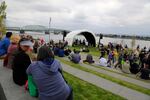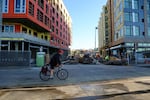More than 150 years ago, Esther Short donated a parcel of land to the city of Vancouver. Short, one of the city’s founders, said the property came with some ground rules: It would be used for economic development and it would connect the community to the waterfront.
On Saturday, that dream was finally fully realized.

Thousands of residents attended the Vancouver Waterfront grand opening Saturday.
Molly Solomon / OPB
Thousands of people gathered Saturday on that same land parcel, 7.3 acres on the shores of the Columbia River, to celebrate the grand opening of the much-anticipated Vancouver Waterfront park.
The $1.5 billion project has been in the works for more than a decade and transforms an area that’s being touted as the new face of Vancouver.
“Vancouver has grown up,” said Mayor Anne McEnerny-Ogle.
“This is an access that we haven’t had for 100 years,” she added. “What a wonderful opportunity to get back to the river."

The area that's recently developed was a former paper mill. After the mill closed in 1996, Boise-Cascade sold off the vacant industrial land to Gramor in 2008.
Gramor Development
City leaders are hoping the new waterfront will draw residents – and maybe even tourists from across the river – to the growing southwest Washington region.
The two riverfront restaurants – Twigs and WildFin American Grill – were open and already bustling with customers. Maryhill Winery from Goldendale, Washington plans to open a tasting room next door by the end of the year.
Still under construction are two apartment buildings, a 138-room Hotel Indigo, and a seven-story office building.
“I think it’s beautiful,” said Drew Finnie, who lives in Orchards and was spending the day exploring the new park with his wife and kids.
“I think it’s about time Vancouver did something like this. It’s something that’s really needed,” he said.
Several city officials gave speeches alongside state and federal representatives who attended Saturday’s ribbon cutting of The Waterfront Vancouver.

The two riverfront restaurants were open and already bustling with customers.
Molly Solomon / OPB
City manager Eric Holmes called the area a world class park and a fantastic day for the city of Vancouver.
“It’s a place where couples will become engaged, where families will celebrate milestones, a place to tell strangers about,” said Holmes. “While those benefits don’t show up well on a spreadsheet or a tax roll, they are perhaps the most enduring of all.”
Mayor McEnerny-Ogle thanked the city’s former mayors and councilors who had the foresight to see what the remnants of a former paper mill could become.
“You saw something special in this old mill site, and you helped our community see that vision,” she said.
Tualatin, Oregon-based Gramor Development purchased the land in 2008 from Boise Cascade, after they shut down paper operations and offered up the area for sale.
“What we wanted to do was replace the paper mill with a top-5 destination for the area,” said Gramor President Barry Cain.
It took a bit longer than Cain expected, and included working with BNSF railroad to run city streets through a berm under the tracks to allow access to the waterfront. The $44 million effort was completed in 2012. The project also survived the great recession, a time when Cain worried they might have to wave a white flag.

A cyclist rides through the new Vancouver waterfront.
Molly Solomon / OPB
But the project endured and Cain was happy to celebrate the first phase of the waterfront opening.
“It’s so nice to be here at a time when the city of Vancouver is ready to put its best foot forward and show its real face,” said Cain.
“Because it hasn’t been able to do that for over a century,” he said. “I think Vancouver is real set up for the future now.”
